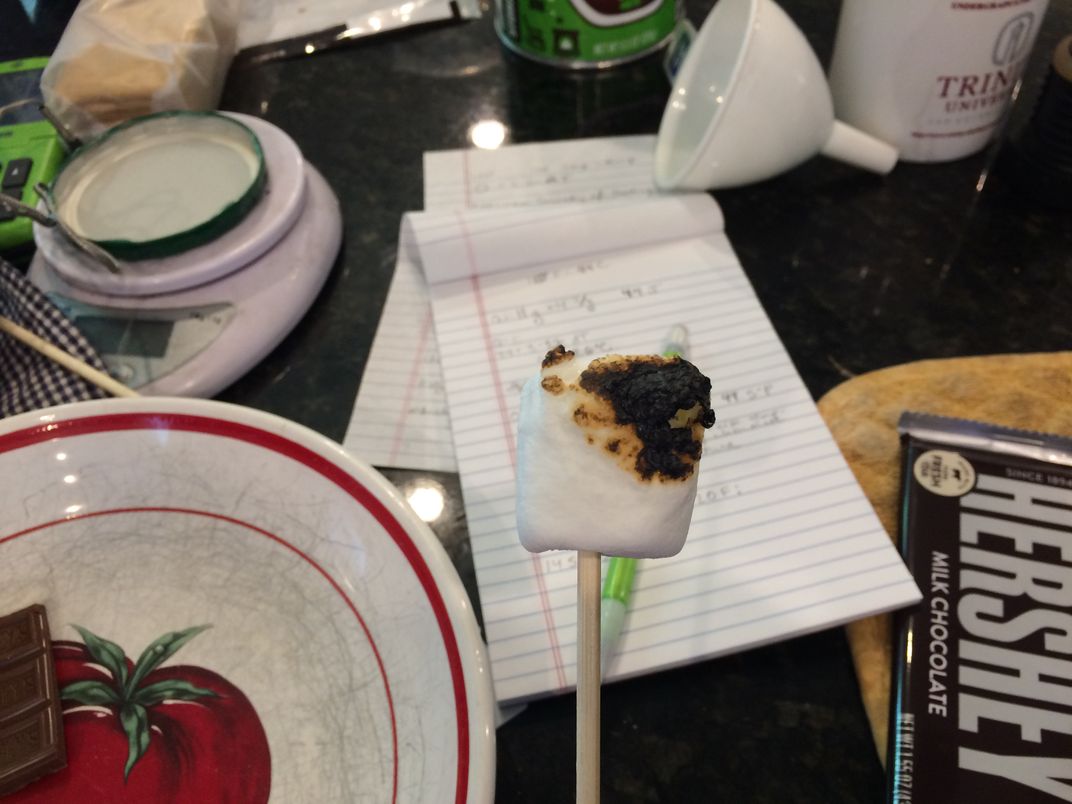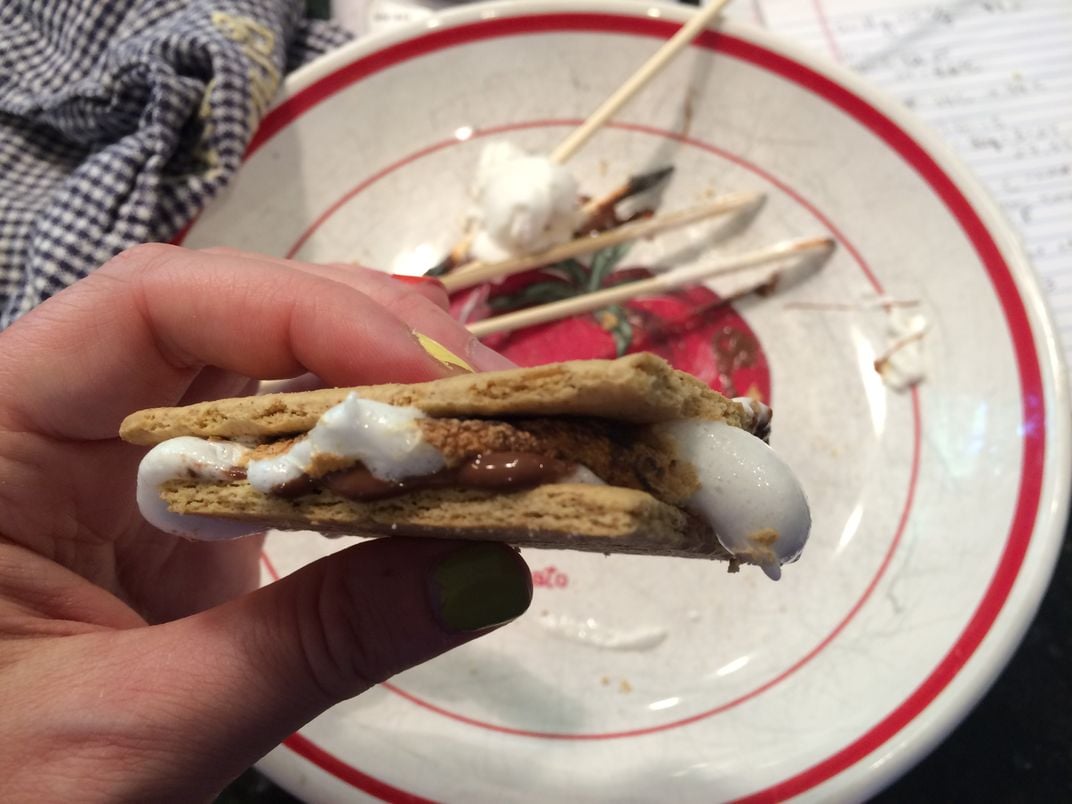The Scientific Quest For the Perfect S’more
A trial by fire
/https://tf-cmsv2-smithsonianmag-media.s3.amazonaws.com/filer/40/e0/40e061ad-6566-4e12-8f92-58764143855e/etgcf6.jpg)
My goal was simple, yet audacious: I wanted to figure out how to make the perfect s’more, that gooey campfire treat composed of chocolate bars and toasted marshmallows sandwiched between two graham crackers. As it turns out, that mouthwatering Platonic ideal poses some challenges for physics and thermodynamics.
This quest for ooey-gooey perfection was triggered by a fierce debate in the Smithsonian.com newsroom: what is the ideal s’more technique? How should you roast the marshmallow so that it melts the chocolate square just right? You see, far too often, the marshmallow isn't hot enough to melt the chocolate, and you end up with inconveniently brittle chocolate. Other times, the outside of the marshmallow is burned to a crisp before the inside melts, and you’re stuck with more bitter char than you want.
Flummoxed by this distressing paradox, my editor turned to me for answers.
I started by going straight to the source: the Girl Scouts. The first documented recipe for a s’more stems from the 1927 publication Tramping and Trailing with the Girl Scouts. The instructions state: “Toast two marshmallows over the coals to a crisp gooey state and then put them inside a graham cracker and chocolate bar sandwich. The heat of the marshmallow between the halves of chocolate bar will melt the chocolate a bit.” And here’s where that famous name comes from: “Though it tastes like ‘some more’ one is really enough,” the handbook advises. (Reader, feel free to disagree.)
Unfortunately, like so many classic recipes, the Girl Scouts’ instructions lacked specificity. (So, it turns out, do the instructions in the classic movie Sandlot.) How crisp? How gooey? How long must the mallows roast? It was time to abandon the Scouts, and turn to thermodynamics.

First, I did away with unnecessary factors: specifically, graham crackers. Don’t get me wrong; the graham is an essential ingredient to the dish, cutting the overwhelming sweetness of melted marshmallows and chocolate and serving as a substrate that allows the dish to be handled by eager hands. But it doesn’t contribute much to the physics of the situation. For that, I merely needed to consider the heat transfer from marshmallow to chocolate.
The relevant bits of physics here are specific heat and latent heat of melting. “Specific heat” is a measure of how much energy it takes to raise the temperature of a given material by a certain amount, usually a degree Celsius or Kelvin. “Latent heat of melting” is a measure of how much energy is required to change the state of a material from solid to liquid, which I wanted the marshmallow to do to the chocolate. Knowing those measurements, I could use standard physics equations to determine how hot a marshmallow needs to be to create the perfect s’more.
In the case of chocolate, the melting point generally goes up the higher the percentage of cacao it contains, largely because milk fat melts at a lower temperature than cocoa butter, and the more milk in the chocolate, the less cacao. Cheap milk chocolate (ideal for s’mores) has around 10 percent cacao, so its melting point is relatively low. At my room temperature of around 80° F, the chocolate is already soft. By 95° it is a puddle. I got around 92° for its melting point in a quick experiment I did using a double boiler and my trusty kitchen thermometer.
I didn’t have the Bunsen burner and lab thermometer necessary to compute the latent heat of melting of chocolate, but I did find it in a handbook published by the American Society of Heating, Refrigeration, and Air-Conditioning Engineers. I found another reference for the specific heat of milk chocolate. I had more trouble tracking down the specific heat of melted marshmallows, so I decided to compute it myself. The specific heat of water is well-documented, so I could use the specific heat of water to compute the specific heat of marshmallow. I put some water in a thermos, added some melted marshmallow, and recorded the temperature change in both substances after some time had passed. By knowing how much energy was required to raise the water temperature, I could figure out how much energy the marshmallow had imparted.
My experimental set-up was far from perfect, but after a few trials, I felt comfortable with my estimate.
To put it all together, I estimated 120° F as a desirable eating temperature for the final creation and weighed the chocolate and marshmallow each s’more would require (11 g and 6.4g, respectively). I only put chocolate on one side of the graham cracker, not both, so I estimated that the chocolate would probably only be getting the energy from roughly half the marshmallow. (The graham cracker would be absorbing some of the rest.) My quick notebook computations suggested I wanted to bring the marshmallow to 160° F for optimal chocolate melting.
It was time for trial by fire.

Could I get the marshmallow to the right temperature, and would it produce optimal s’mores? I conducted my experimental research over the gas flames of my stove, which gives more control of the flame and makes it easier to monitor the temperature of the marshmallow over the course of the experiments. These flames are a bit hotter than those of wood or coal fires, but they’re in the same ballpark, and I think my results will translate to the campfire.
With the marshmallow skewered with both a stick and the probe of my food thermometer—not an easy task—I started to apply heat. I love burnt marshmallows, so my tendency is to plunge the marshmallow right in to the fire and let it get good and charred immediately. That turned out to be far from ideal. When the outside was 150° F and completely blackened, the inside was barely over 100° F. The chocolate would get slightly melty, but the marshmallow would run out of heat before the chocolate was truly gooey. With a more patient approach, holding the marshmallow farther from the flame, I was able to get the whole thing to heat up at around the same rate.
(This realization brought to mind another scientific experiment involving marshmallows: the infamous Harvard Marshmallow Test. But in this case, instead of delaying gratification to get two treats, the trick was: delay your gratification, and your treat will be twice as good.)
When the thermometer hit 160° F, I removed the marshmallow and, with trepidation, slid it onto the chocolate and graham cracker. The chocolate melted delightfully, completely goopy at one end and still slightly coherent at the end that got marshmallowed slightly later. If anything, the chocolate might have been slightly too melty. A subsequent trial with a 150° F marshmallow was successful as well. 140° F wasn’t quite enough to get the chocolate gooey enough.
A few caveats: You probably won’t be taking a food thermometer to your next campfire, and your conditions may be different from mine. My kitchen is quite warm right now, so my chocolate started out very close to its melting point. If you’re cooking over a campfire on a cool night, you might need a warmer marshmallow to bring the chocolate up to its melting point.
That said, here is my highly scientific s’mores recipe.
Materials
- 1 graham cracker, broken in half
- 3 rectangles of cheap milk chocolate
- 1 large marshmallow
Method
-
Place the chocolate on half of the graham cracker.
-
Using one or two skewers (two skewers gives you better control of marshmallow placement and lowers the chances of dropping a marshmallow into the fire), start roasting a marshmallow over a fire, keeping it far enough from the flame that it doesn’t actually catch fire.
-
As the marshmallow warms up, it will expand slightly and sag around the skewers. You want to remove it as it crosses the line from moderately to very saggy. If you like burnt sections on your marshmallow, char it quickly before removing it from the heat.
-
Place the marshmallow on the chocolate. Slide it off the skewers using the second half of the graham cracker. Repeat as desired.
As with any important skill, practice makes perfect, and you’ll need to try and try again as you work towards the optimal s’more. National S’mores Day is observed on August 10. Can you perfect your s’mores technique before then?